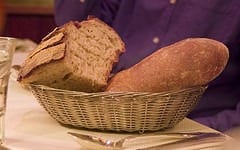An American company has developed a technique that it says can make bread stay mould-free for 60 days.
The bread is zapped in a sophisticated microwave array which kills the spores that cause the problem.
The company claims it could significantly reduce the amount of wasted bread – in the UK alone, almost a third of loaves purchased.
The technique can also be used with a wide range of foods including fresh turkey and many fruits and vegetables.
World of waste
Food waste is a massive problem in most developed countries. In the US, figures released this year suggest that the average American family throws away 40% of the food they purchase – which adds up to $165bn (£102bn) annually.
Bread is a major culprit, with 32% of loaves purchased in the UK thrown out as waste when they could be eaten, according to figures from the Department for Environment, Food and Rural Affairs (Defra).
One of the biggest threats to bread is mould. As loaves are usually wrapped in plastic, any water in the bread that evaporates from within is trapped and makes the surface moist. This provides excellent growing conditions forRhizopus stolonifer, the fungus that leads to mould.
In normal conditions, bread will go mouldy in around 10 days.
But an American company called Microzap says it has developed a technique that will keep the bread mould free for two months.
At its laboratory on the campus of Texas Tech University in Lubbock, chief executive Don Stull showed off the long, metallic microwave device that resembles an industrial production line. Originally designed to kill bacteria such as MRSA and salmonella, the researchers discovered it could kill the mould spores in bread in around 10 seconds.
“We treated a slice of bread in the device, we then checked the mould that was in that bread over time against a control, ” he explained.
“And at 60 days it had the same mould content as it had when it came out of the oven.”
Question of taste
The machine the team has built uses much the same technology as found in commercial microwaves – but with some important differences, according to Mr Stull.
“We introduce the microwave frequencies in different ways, through a slotted radiator. We get a basically homogeneous signal density in our chamber – in other words, we don’t get the hot and cold spots you get in your home microwave.”
via BBC – Matt McGrath
The Latest Streaming News: Food waste updated minute-by-minute
Bookmark this page and come back often
Latest NEWS
Latest VIDEO








